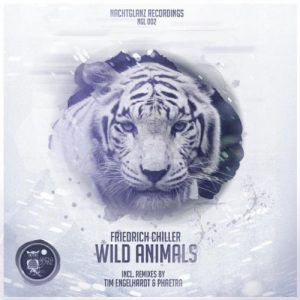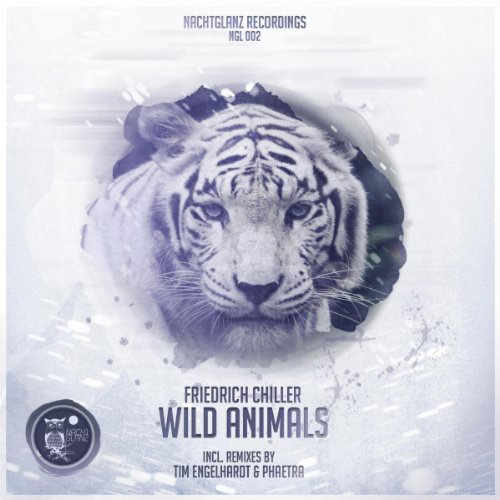 Nachtglanz Recordings, an independent electronic record label based out of Schacht-Audorf, Germany, has been producing music since early 2011. The label specializes in House Music, Techno, and Electronica, and they’ve released albums by artists such as Ariane Blank, Head of Shoes, Bags and Boys, and Stoneman. One of the labels newest releases comes from fourteen-year-old (!) Lorenz Feilke, also known as Friedrich Chiller, and is entitled “Wild Animals.” The EP is a collection of remixes done by label founders Tim Engelhardt and Phaetra, exhibiting Nachtglanz’s desire to be intimately connected with the material they release. However, the question still remains: are these remixes simply paying loyalty to the original mix, or are they attempts to make the music something different entirely?
Nachtglanz Recordings, an independent electronic record label based out of Schacht-Audorf, Germany, has been producing music since early 2011. The label specializes in House Music, Techno, and Electronica, and they’ve released albums by artists such as Ariane Blank, Head of Shoes, Bags and Boys, and Stoneman. One of the labels newest releases comes from fourteen-year-old (!) Lorenz Feilke, also known as Friedrich Chiller, and is entitled “Wild Animals.” The EP is a collection of remixes done by label founders Tim Engelhardt and Phaetra, exhibiting Nachtglanz’s desire to be intimately connected with the material they release. However, the question still remains: are these remixes simply paying loyalty to the original mix, or are they attempts to make the music something different entirely?
The opening track, “Wild Animals (Original Mix),” begins with a smooth, subdued bass line surrounded by samples of people screaming, laughing, and making strange noises, creating a mysterious, intriguing atmosphere. Around one minute, the piano kicks in with lush, heavy chords, and is layered with cool eerie vocals singing “Over your head, under your bed, animals.” The song continues in this fashion for a while without much change: a quiet, yet danceable beat, accentuated by thick piano chords and those freaky vocal samples chattering in the background. The end of the tune is a slow decay, leaving nothing but the drumbeat and bass line pulsing faintly at the end. I found the track engaging and enjoyable overall. The atmosphere construction is certainly successful, leaving listeners feeling uneasy and vaguely paranoid, but I did feel there could have been more attention paid to energy building, as most of the track is steady and predictable.
The second track, entitled “Wild Animals (Tim Engelhardt Remix) attempts to make up for the static energy level felt in track number one. The song opens with a heavy dance beat, subtly layered with auxiliary synth percussion, causing the energy and complexity of the music to increase. Then, with a burst of sound from a white noise generator, the music gives way to a high-energy dance groove, with thudding tribal drums and a spacey, distorted synth melody. The track continues steadily uphill until it reaches its peak around 2:30, with the introduction a grungy, dubstep bass line, highlighting the sense of menace operating beneath the music.
Ultimately, I felt this track succeeded in establishing a fluid energy arc from one idea to the next, and thus was a more successful song than the original, however, on a personal level, I found myself desiring to hear the piano part again, as it grounded and gave direction to the original track. Furthermore, I felt there was a lack of individuality exhibited throughout the music. That is, I felt Engelhardt was simply highlighting various aspects of the original mix in order to call the track his own.
The following track, “Wild Animals (Tim Engelhardt Dub mix),” exhibits exactly the same structure, instrumentation, and tones as the previous track. The only differences are that all vocal samples are omitted, and the bass line is made a bit more pronounced. I feel like the intention behind reusing the same material lay in the desire to transform the original tune into a hard-hitting dance tune, but from a critical standpoint, I see this track as a cop out, as no new material is explored.
The final track on the EP, “Wild Animals (Pahetra Dub Mix),” makes up for the previous track’s insecurities, as the music is spun in an entirely new direction. This track features a funk bass line and drum beat, making the underlying pulse of the music more aggressive than the album’s previous tracks. Around 1:30, an ominous drone is introduced beneath the music, adding subversive, frictional energy to the tune. And around 3:30, a sludgy synth organ brings the track to its peak, making the music harsh at its core, and fuzzy at the edges; a fully immersive experience for the listener. This was the most successful remix on the album by far, as Pahetra was not afraid to take risks with the original material and move it in an entirely new, and equally satisfying direction.
On the whole, I found this to be a pretty solid EP. The original mix holds its own against its remixes, flaunting its malleability and vulnerability through spacious, disquieting atmospheres. The two middle tracks are the weakest, as they simply highlight different aspects of the original mix, but do nothing to change or alter the music in any drastic fashion. And the final track may be the strongest on the EP due to its audacity in taking risks with the original material so as to change the feel of the music entirely. In a way, “Wild Animals” calls to question whether any loyalty needs to be paid to an EDM artist when remixing his or her music, and honestly, after listening to this EP, I’d say that all musical material in the EDM world, once recorded, can and should be altered with the intention of making music unique and personal to the remixing artist.




